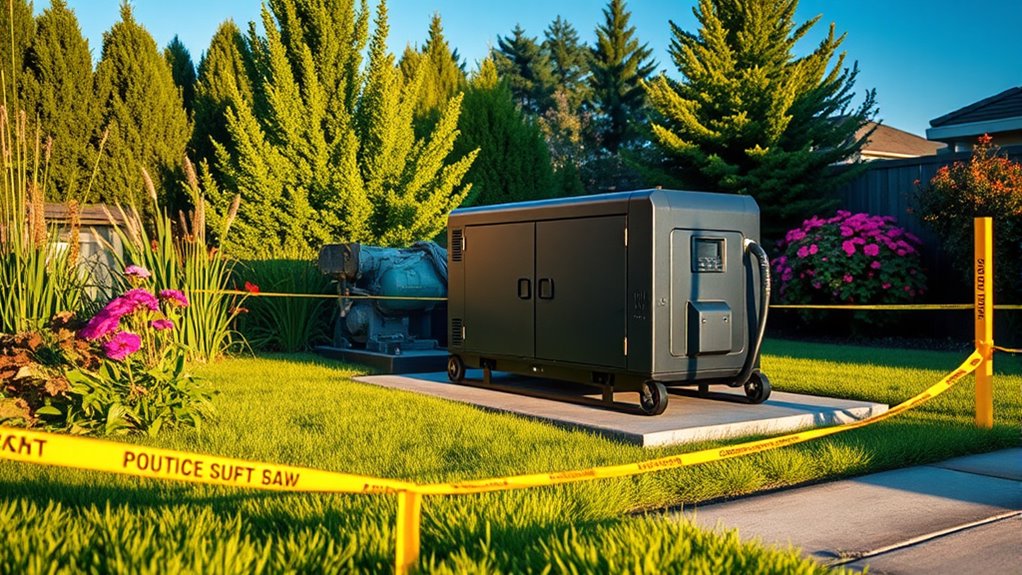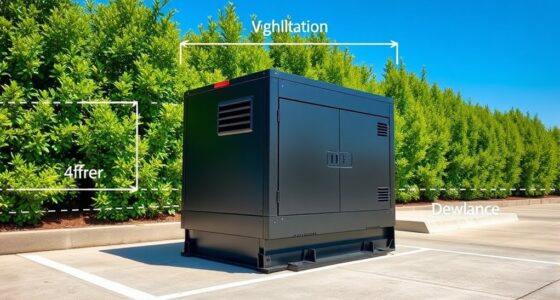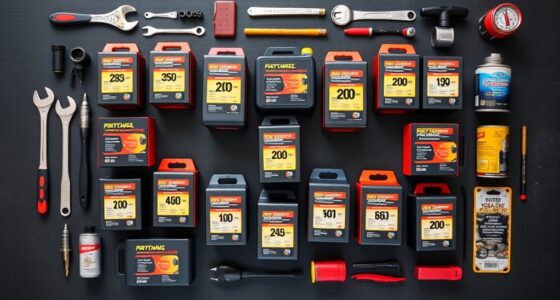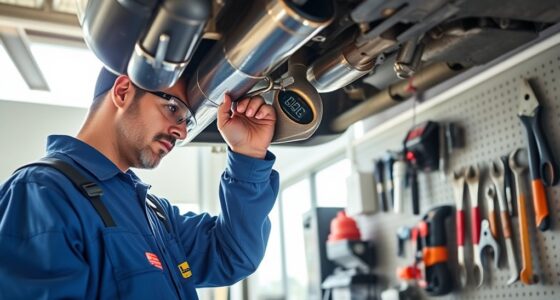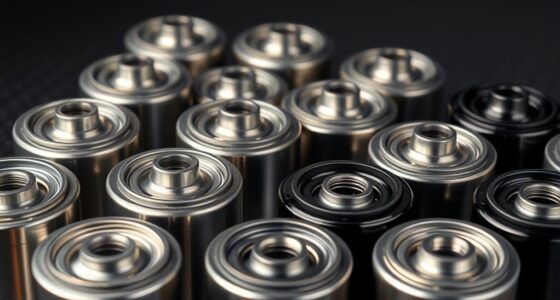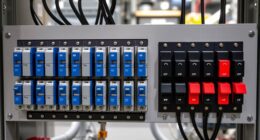Many people believe any outdoor spot is safe for a generator or that distance from the house doesn’t matter as long as it’s outside. They also think setbacks are the same regardless of size, placement doesn’t affect noise or efficiency, and placing units near windows or on flammable surfaces is fine. But proper placement, setbacks, wind considerations, and reevaluation after installation actually matter for safety and performance. If you keep going, you’ll discover the truth behind these common misconceptions.
Key Takeaways
- Wind direction has minimal impact on safe generator placement when proper setbacks and ventilation are maintained.
- Setback distances are primarily for safety and noise reduction, not just for complying with community standards.
- Generator covers reduce noise but do not replace proper setbacks and ventilation for exhaust safety.
- Placement on flammable surfaces like wooden decks is risky; proper clearance and fire-resistant materials are essential.
- Once correctly installed following safety guidelines, repositioning is rarely needed unless environmental conditions change.
Any Outdoor Spot Is Safe for Placement
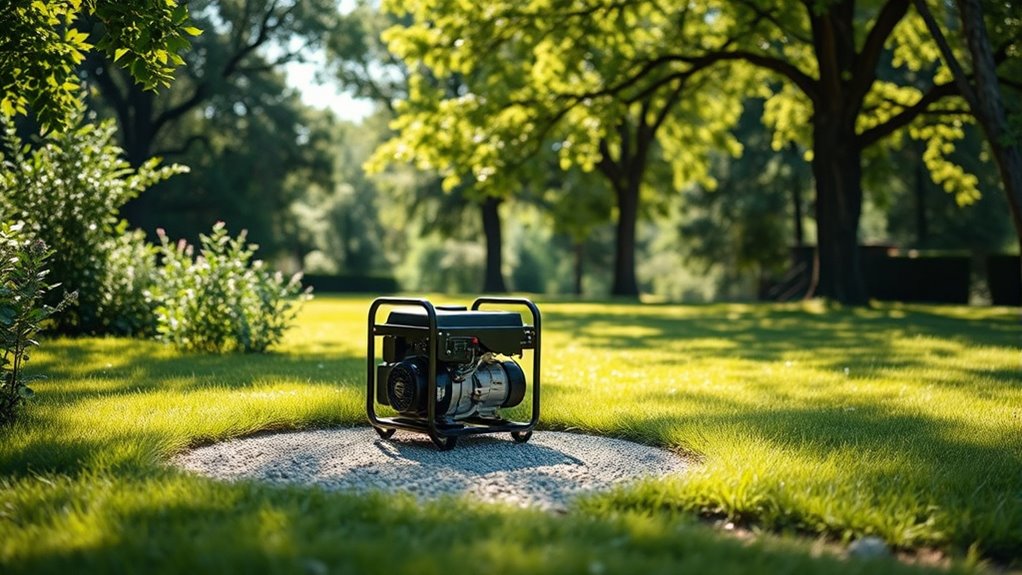
Many people assume that any outdoor spot is suitable for placing a generator, but in reality, this can be dangerous. Overlooking outdoor safety and setback misconceptions can lead to hazardous situations. Just because a location is outside doesn’t mean it’s automatically safe; factors like wind direction, nearby structures, and ventilation matter. You might think a spot far from your home is ideal, but if it’s too close to windows or ventilation intakes, fumes could enter your living space. Additionally, uneven ground or enclosed areas can cause exhaust buildup or instability. Always evaluate your outdoor environment carefully. Proper setback distances aren’t just suggestions—they’re essential for safety. Ignoring these guidelines puts you at risk of carbon monoxide poisoning, fires, or other accidents.
Distance From the Home Doesn’T Matter as Long as It’s Outside
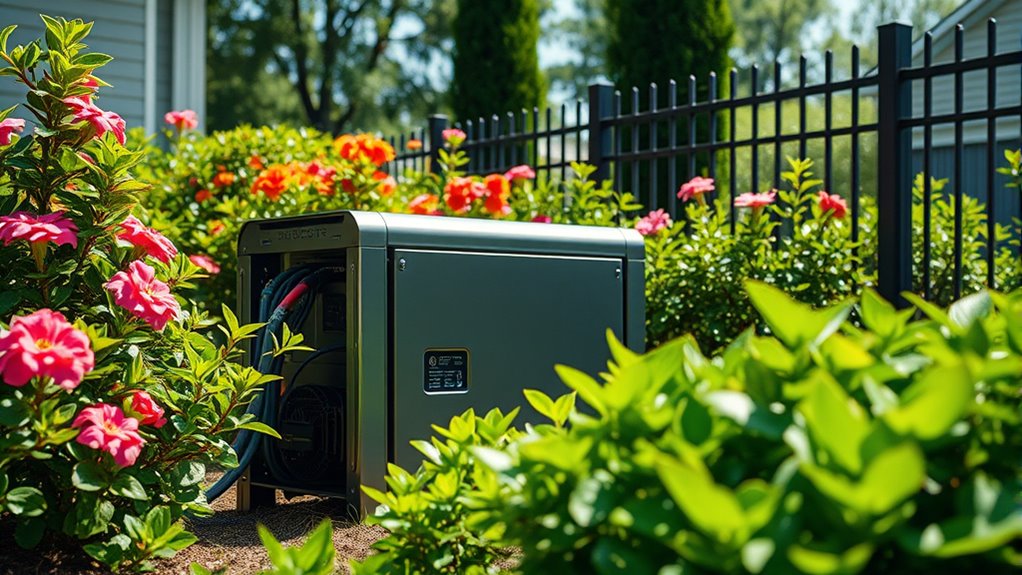
Just because a generator is placed outside doesn’t mean you can ignore the recommended setbacks from your home. Distance matters because it helps reduce fire hazards and guarantees proper ventilation. Placing a generator too close can lead to dangerous exhaust buildup, increasing the risk of carbon monoxide poisoning. Even outdoors, inadequate setbacks can trap fumes or cause heat to build up, creating fire hazards. Ventilation importance can’t be overstated—adequate space allows fumes to dissipate safely and prevents overheating. Remember, the goal is to keep your generator far enough away so fumes don’t enter your home and so heat and exhaust don’t pose safety risks. Following setback guidelines isn’t just about legality; it’s about protecting your household from potential hazards. Proper distance is a vital part of safe generator operation. Maintaining proper clearance is essential to ensure effective airflow and prevent any safety issues.
All Setbacks Are the Same Regardless of Generator Size

While it might seem convenient to assume that the same setback distances apply to all generators, size does matter when it comes to safety. Larger generators produce more exhaust and pose greater risks if placed too close to your home or neighbors. Setback regulations are designed to account for these differences, meaning bigger units require greater distances to prevent carbon monoxide buildup and fire hazards. Smaller generators might be allowed closer to structures, but that doesn’t mean safety should be overlooked. Always check local codes, as they specify setback distances based on generator size. Ignoring these distinctions can lead to dangerous situations, including exhaust poisoning or accidental fires. Properly understanding generator size and adhering to setback regulations ensures safe operation and peace of mind. Additionally, exhaust emissions can be more harmful from larger units if not properly maintained and placed at recommended distances.
Placement Doesn’T Affect Fuel Efficiency or Noise Levels

Placement of your generator does not substantially impact its fuel efficiency or noise levels. Many fuel efficiency misconceptions lead people to think that placing their generator closer or farther from the home changes how much fuel it uses. Similarly, noise level myths suggest that positioning the unit differently will greatly affect how loud it sounds. In reality, factors like engine design, load, and maintenance play a much bigger role in fuel consumption and noise output. Proper placement mainly influences safety and ventilation, not efficiency or sound. You shouldn’t focus solely on distance to reduce noise or improve fuel economy. Instead, prioritize safe setbacks and ventilation to ensure your generator operates safely and reliably without falling for these common myths. Understanding the importance of vetted information helps you make informed decisions about generator setup and safety.
It’s Okay to Place a Generator Near Windows or Vents
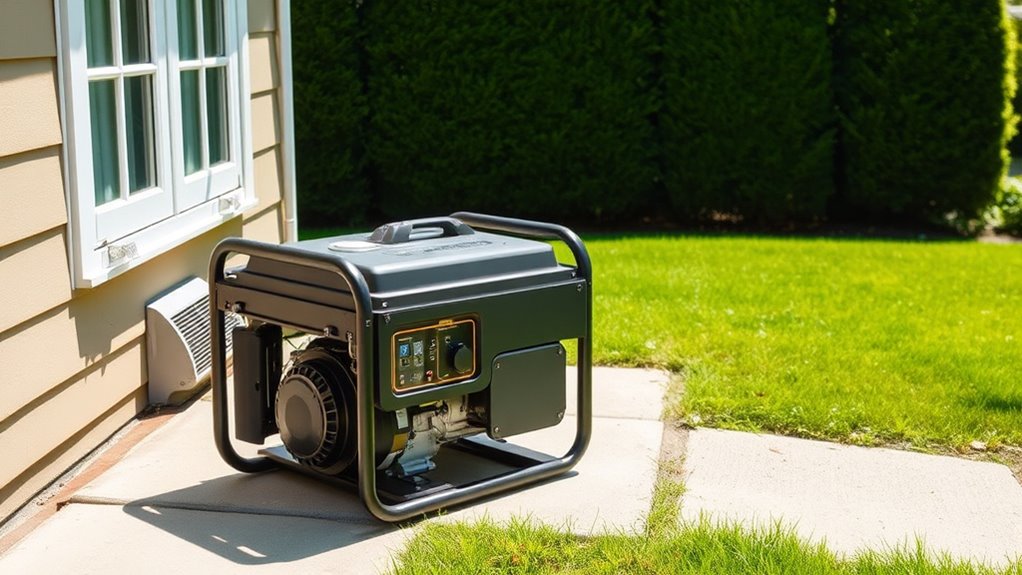
You can place your generator near windows or vents without automatically risking dangerous fumes, but it’s important to do so correctly. Proper weather protection, like a canopy or enclosure, helps shield the generator from rain and snow, reducing the risk of damage. Positioning it near vents or windows can also aid in noise reduction; placing the unit behind barriers or inside a shed minimizes sound transmission into your home. Just ensure exhaust fumes won’t enter living spaces and that ventilation remains unobstructed. Additionally, understanding projector placement guidelines can help optimize safety and performance when setting up equipment close to windows or vents. While close placement isn’t inherently unsafe when done thoughtfully, always verify local codes and manufacturer guidelines. With careful planning, you can enjoy the benefits of convenient placement while maintaining safety, weather resilience, and comfort.
Ventilation Isn’T Necessary if the Generator Is Outdoors
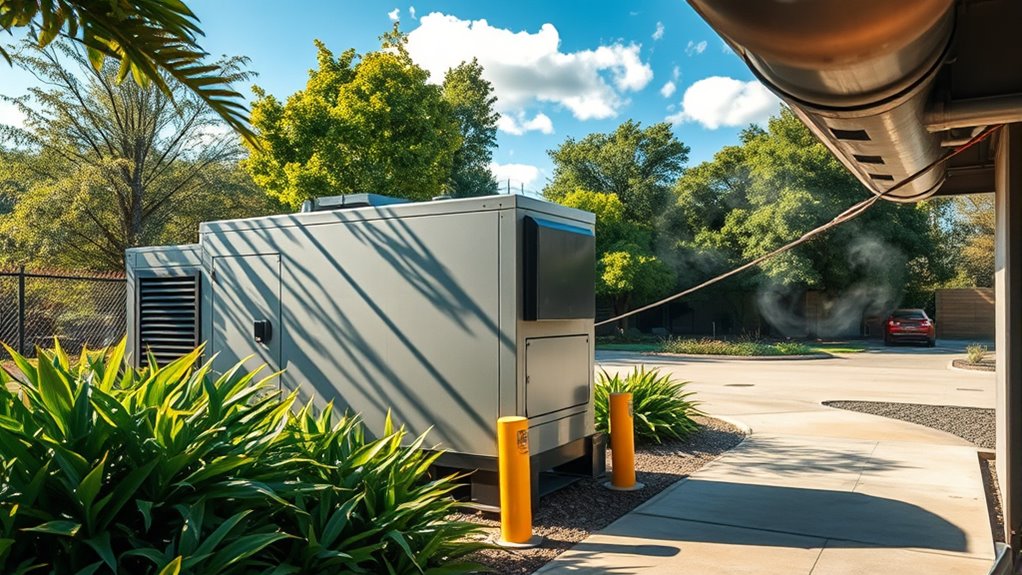
Many assume outdoor placement means ventilation isn’t needed, but that’s not entirely true. Proper ventilation is still essential to prevent dangerous fumes from accumulating nearby. Even outdoors, you must consider limitations to guarantee safety. For example, air circulation can be limited by environmental factors, so ensuring adequate airflow around the generator is crucial.
Proper Ventilation Importance
When operating a generator outdoors, proper ventilation becomes less critical because the open environment allows exhaust gases to disperse quickly. However, ventilation safety remains essential to prevent dangerous carbon monoxide buildup. Even outside, wind can direct fumes toward your home, creating hazards. Ensuring good airflow around the generator reduces risks and maintains safe operation. Remember, carbon monoxide is a colorless, odorless gas that can be deadly if inhaled in high concentrations. Proper placement and awareness are key to safe operation. To enhance safety, consider these factors:
- Position the generator away from windows and doors
- Maintain a clear, unobstructed airflow path
- Regularly check for signs of exhaust buildup
- Never operate indoors or in enclosed spaces
- Use proper ventilation techniques to ensure exhaust gases do not accumulate, especially in areas where wind may influence the dispersion.
Outdoor Placement Limitations
Operating a generator outdoors often means ventilation concerns are less pressing because fresh air quickly disperses exhaust gases. However, outdoor placement isn’t without limitations. You still need to follow setbacks regulations to ensure safety and compliance. Keep your generator a safe distance from your home, windows, doors, and vents to prevent carbon monoxide buildup inside. While ventilation isn’t a concern outdoors, proximity to structures or combustible materials can pose fire hazards. Check local codes to determine the minimum setbacks required for outdoor placement, as these rules vary widely. Ignoring these regulations can lead to dangerous situations or legal issues. Remember, even outdoors, maintaining proper setbacks helps protect your family and property while ensuring your generator operates safely. Additionally, understanding setback regulations can help you avoid fines and ensure your setup meets local safety standards.
Proper Setbacks Are Only a Local Requirement, Not a Safety Issue
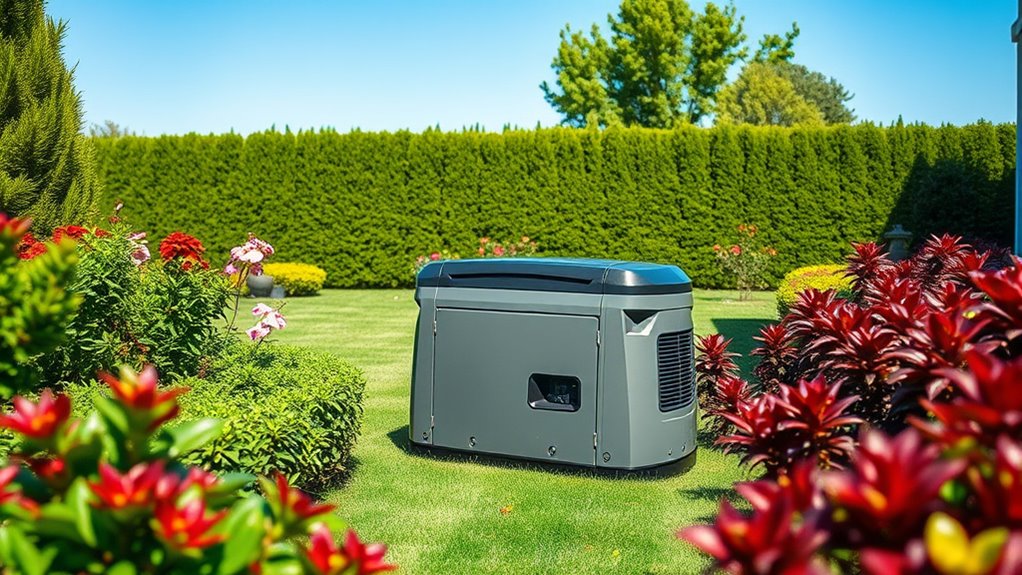
Proper setbacks are often viewed as just a local requirement, but they don’t necessarily address safety concerns. Local codes can vary widely and may not reflect the best safety practices for generator placement. It’s important to understand that these setbacks are more about compliance than actual safety. Additionally, choosing the correct air quality measures can help mitigate health risks associated with improper generator placement.
Local Codes Vary
While local codes often specify setback distances for generators, these requirements are primarily about adhering to community standards rather than directly guaranteeing safety. Local ordinances can vary widely, making it essential to understand your area’s specific rules. However, these codes don’t necessarily address safety misunderstandings or prevent hazards directly. Instead, they focus on minimizing noise, protecting neighboring properties, and maintaining aesthetic standards. Relying solely on local codes can lead to misconceptions about safety. Remember, just because a setback meets local requirements doesn’t mean it’s the safest location. Always consider manufacturer guidelines and expert advice for ideal placement. Proper generator placement involves more than just following local ordinances—it requires a thorough approach to safety and functionality. Generator safety best practices should always be closely followed regardless of local code requirements.
Not Safety-Driven
Many people assume that meeting setback requirements automatically guarantees safety, but that’s not the case. Placement myths and setback misconceptions often lead to the belief that local setback rules ensure your generator’s safety. In reality, proper placement isn’t solely about meeting local codes; it’s about reducing risks like carbon monoxide poisoning, fire hazards, and noise disturbances. Relying only on setback requirements can be dangerous because they vary by location and don’t always address safety concerns directly. A generator placed just beyond the minimum setback might still pose hazards if not carefully positioned. Always prioritize safety by considering airflow, ventilation, and proximity to windows and doors, rather than just ticking off local setback boxes. Proper, safety-driven placement saves lives and prevents accidents. Additionally, understanding payment processing can help ensure your safety measures are financially supported and correctly implemented.
Using a Generator Cover Eliminates the Need for Setbacks

Using a generator cover might seem like a simple fix to reduce the need for setbacks, but it doesn’t eliminate safety concerns. Relying solely on generator covers can lead to overlooked risks, as setbacks serve a crucial purpose beyond just containment. Many believe that covers negate the need for proper placement, but this is a setback myth. Covers can prevent debris and reduce noise, yet they don’t protect against carbon monoxide leaks or fire hazards. Proper setbacks ensure adequate airflow and minimize exposure to flammable materials.
- Generator covers help with noise reduction but don’t address ventilation issues
- Setbacks are designed to prevent exhaust buildup, not just contain noise
- Covers don’t eliminate the risk of carbon monoxide poisoning
- Safety experts still recommend following setback guidelines for maximum protection
Generators Can Be Safely Installed on Wooden Decks or Flammable Surfaces
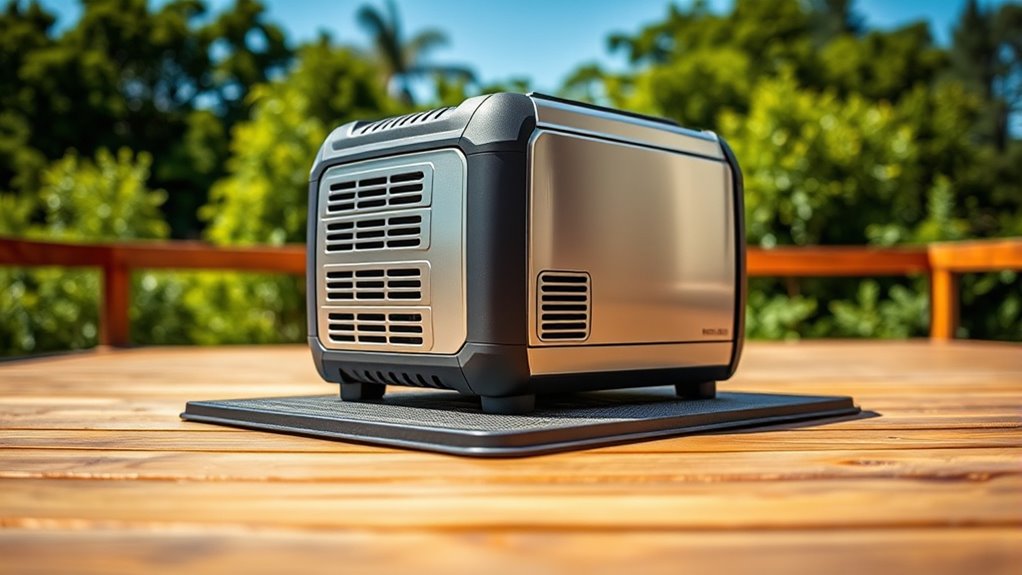
You might think installing a generator on a wooden deck is safe, but proper precautions are essential. Make certain there’s adequate ventilation to prevent dangerous fumes, and use fire-resistant materials to reduce fire risk. Always follow local building codes to keep your setup safe and compliant.
Proper Ventilation Essential
Proper ventilation is essential when installing a generator, especially on wooden decks or flammable surfaces, to prevent dangerous buildup of carbon monoxide and heat. Many fall for ventilation myths that suggest closing vents or blocking airflow; these misconceptions can lead to hazardous conditions. To ensure safety, avoid setback misconceptions that underestimate the importance of proper clearance and airflow. Instead, follow these guidelines:
- Maintain at least 20 feet of distance from windows and doors
- Ensure unobstructed airflow around the generator
- Install exhaust outlets away from living areas
- Regularly inspect vents and exhaust paths for blockages
Use Fire-Resistant Materials
When installing a generator on wooden decks or other flammable surfaces, selecting fire-resistant materials is essential to minimize fire risks. Using fire-resistant materials around your generator can help prevent sparks or heat from igniting a fire. These materials act as a barrier, reducing the chance of combustion if a spark occurs. Keep in mind that setback regulations often specify how close the generator can be placed to flammable surfaces, so check local codes before installation. Incorporating fire-resistant mats, pads, or barriers beneath and around the generator ensures added protection. This proactive step not only enhances safety but also helps you comply with setback regulations designed to prevent fire hazards. Prioritizing fire-resistant materials is a simple yet crucial measure in safe generator placement.
Follow Local Building Codes
Following local building codes is essential to guarantee safe generator installation on wooden decks or other flammable surfaces. These codes specify setbacks, ventilation, and grounding requirements, ensuring your generator operates safely and efficiently. Adhering to regulations also supports proper generator maintenance and noise reduction, minimizing hazards and disturbances. To meet code requirements, consider these key points:
- Verify setback distances from structures and combustible surfaces
- Use approved, fire-resistant mats or pads beneath the generator
- Ensure adequate ventilation to prevent carbon monoxide buildup
- Install appropriate grounding systems to reduce electrical risks
Positioning a Generator Closer to the House Improves Backup Power Performance
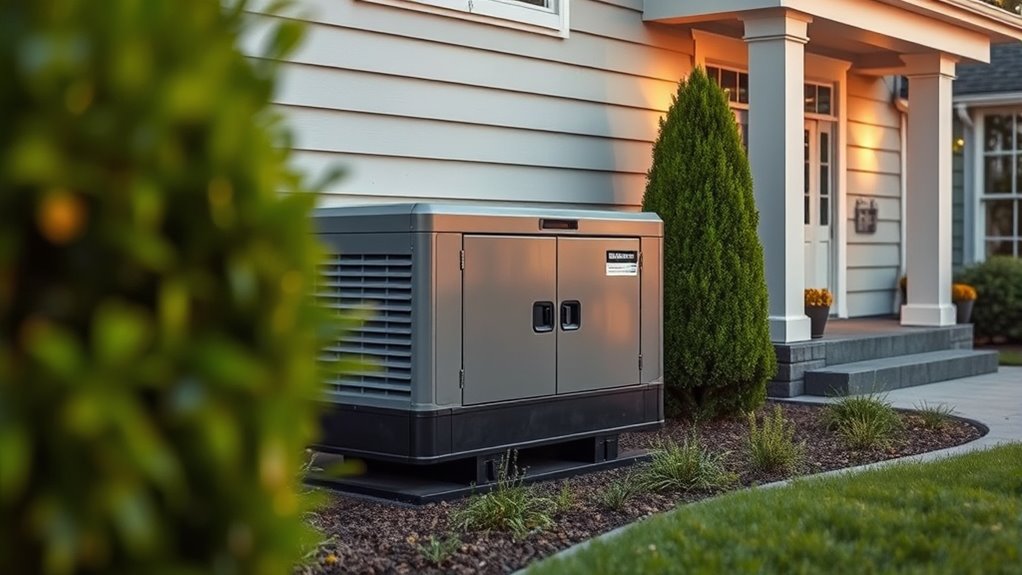
Placing your generator closer to the house can substantially boost backup power performance. Proper generator placement guarantees efficient power transfer and reduces electrical losses. While setback requirements are essential for safety, they also influence performance—placing the generator too far away can cause voltage drops and delays during outages. By positioning the generator within the recommended setback limits, you minimize the distance electricity must travel, resulting in quicker response times and more reliable power. Additionally, closer placement makes maintenance easier and allows for better ventilation and noise management. Just be sure to adhere to local setback requirements to balance safety and performance. Overall, strategic generator placement near your home enhances backup system effectiveness without compromising safety standards.
Wind Direction Doesn’T Influence Safe Placement Choices

Wind direction doesn’t substantially impact where you should place your generator for safety. Many believe wind influence plays a major role, but this is a common placement myth. Instead, focus on factors like noise, exhaust fumes, and accessibility. Proper placement minimizes risks regardless of prevailing wind patterns.
Consider these points:
- Keep the generator away from windows and vents to prevent exhaust intrusion.
- Ensure it’s on a stable, level surface for safety and durability.
- Maintain sufficient clearance from structures for proper ventilation.
- Position it where it’s easily accessible for maintenance and refueling.
Understanding that wind influence doesn’t dictate safe placement helps you avoid unnecessary restrictions and ensures safer operation. Don’t fall for placement myths—prioritize practical safety considerations over wind direction.
Once Installed, Generator Placement Doesn’T Need to Be Reevaluated
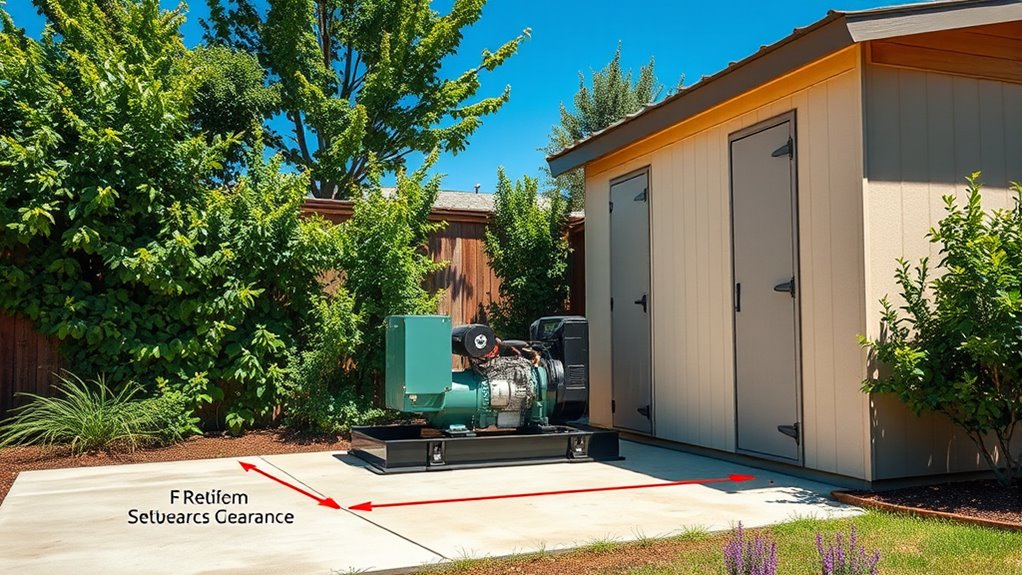
Once you’ve installed your generator in a safe and well-considered location, there’s generally no need to reevaluate its placement unless circumstances change. Many people believe in maintenance myths that suggest repositioning is necessary over time, but this isn’t true if your setup remains safe and compliant. Placement myths often lead homeowners to second-guess their initial decision, but proper planning from the start minimizes future concerns. Regular maintenance focuses on keeping the unit functioning efficiently, not on relocating it. If your environment or usage changes considerably, then reevaluation makes sense. Otherwise, once your generator is properly installed, it can serve reliably without constant reassessment of its placement. Trust your initial judgment and focus on maintenance rather than unnecessary repositioning.
Frequently Asked Questions
How Do Local Building Codes Influence Generator Setback Requirements?
Local building codes directly influence your generator setback requirements through local code enforcement, which enforces setback regulations to make certain safety and compliance. You need to check your area’s specific rules, as they dictate how far your generator must be placed from property lines, structures, and windows. Failing to follow these regulations can result in fines or safety hazards, so always consult your local codes before installing your generator.
What Are the Fire Risks of Placing Generators Near Flammable Materials?
Placing a generator near flammable materials sparks a dangerous fire hazard—like a lit match to dry leaves. If you don’t keep it well away, sparks or heat could ignite nearby combustible items, leading to rapid flames. To keep your home safe, guarantee the generator is positioned far from flammable materials, reducing the risk of a fire spreading. Proper placement acts as your first line of defense against potential catastrophe.
How Does Generator Placement Impact Overall Safety During Operation?
Your generator placement directly impacts safety during operation by ensuring proper ventilation, which prevents dangerous exhaust buildup. Position it away from windows and vents to reduce carbon monoxide risks. Additionally, strategic placement can help with noise reduction, minimizing disturbance to your surroundings. Always follow manufacturer guidelines to optimize ventilation and safety, and consider barriers or enclosures to further decrease noise levels. Proper placement keeps everyone safer and maintains efficient generator operation.
Are There Specific Environmental Considerations for Outdoor Generator Placement?
Imagine the gentle rustling of leaves as you consider outdoor generator placement. You should think about environmental impact and wildlife disturbance, ensuring your generator isn’t too close to natural habitats. Select a spot with good ventilation, away from water sources, and avoid areas with sensitive ecosystems. By doing so, you protect local wildlife and minimize noise pollution, keeping your setup eco-friendly and safe for everyone and everything around you.
What Are the Best Practices for Maintaining Safe Generator Distances Over Time?
To maintain safe generator distances over time, you should regularly check clearances to prevent fuel leaks and guarantee safety. Keep the generator away from windows and vents to reduce noise and improve noise reduction. Also, make certain proper ventilation for fuel efficiency and safety, avoiding obstructions that could lead to overheating. Periodic inspections and adjustments help sustain safe distances, optimize fuel use, and minimize noise disturbances.
Conclusion
Remember, safe generator placement isn’t about luck or guesswork. It’s about understanding the right distances, considering environmental factors, and following proper setbacks. It’s about avoiding hazards, optimizing performance, and ensuring safety. It’s about planning carefully, installing correctly, and reevaluating periodically. By staying informed, respecting guidelines, and making smart choices, you protect your home, your family, and your peace of mind—all while keeping your generator running smoothly and safely.
